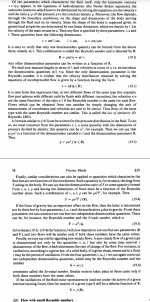The roozen paper refers to:what formula to use.
P. Merkli and H. Thomann, “Thermoacoustic effects in a resonance tube,” (1975), published at ETH zurich.
The access to the paper seems to be restricted.
I'll try to find a way!
Thank you @Dmitrij_S ,
the strouhal number seems to relate a "characteristic dimension" (not further defined, can be diameter, radius ...) to the particle displacement.
In addition your reference seems to give an inverse value (displacement/characteristic dimension).
So in future whenever I refer to strouhal number I should probably include the dimension and definition it refers to, which is the port radius (effective port exit radius in my specific case), following roozen and merkli/thomann.
the strouhal number seems to relate a "characteristic dimension" (not further defined, can be diameter, radius ...) to the particle displacement.
In addition your reference seems to give an inverse value (displacement/characteristic dimension).
So in future whenever I refer to strouhal number I should probably include the dimension and definition it refers to, which is the port radius (effective port exit radius in my specific case), following roozen and merkli/thomann.
Last edited:
I think I may have found the reason for different definitions of Sr.See the calculator site linked below (characteristic length = port diameter):
The "classic" strouhal number relates to a solid cylinder in a fluid flow, see wikipedia. Strouhal himself apparently studied cables oscillating in the wind, caused by vortex shedding.
With a loudspeaker port the number relates to a fluid flow inside a (hollow) cylinder.
Anyone has more knowledge about this?
V.M.Garcia-Alcaide et al. studied turbulence in ports using the CFD modeling package OpenFOAM. They also used the definition of the Strouhal number given by Roozen, and used the radius of the port rounding as a characteristic size. It seems that Roozen's definition of the Strouhal number is quite well-established in the ports turbulence studies.
Attachments
@Dmitrij_S
thank you very much for pointing me to this paper and confirming the definition of strouhal number by roozen!
It's encouraging to see how similar the flow simulation/high speed camera images are to my slow motion videos!
thank you very much for pointing me to this paper and confirming the definition of strouhal number by roozen!
It's encouraging to see how similar the flow simulation/high speed camera images are to my slow motion videos!
Last edited:
Excellent read! Reminds me of how race cars create downforce with ground effects...under the front of the car takes incoming air pressure (inner flare of the port), speeds up the air in the middle of the car (middle tube of the port), and then slow down the air with rear diffusers for higher cornering speeds (outer flare of the port).


Last edited:
have a look at the roozen paper:
It is interesting that the Roozen Strouhal number definition is in effect the same as the one given by the general formula if the characteristic length is assumed to be the port tube circumference, rather than the diameter.
General formula:
St = f * L / V
Where:
St = Strouhal number
V = Velocity
L = Characteristic length
f = Frequency
If characteristic length = circumference then L = 2 * pi * port radius
St = f * (2 * pi * port radius) / V
St = port radius / (V / (2 * pi * f))
Particle displacement = V / (2 * pi * f)
St = port radius / particle displacement
I gather that you would prefer to use the Strouhal 'circumference' definition rather than the 'diameter' one, and that the design aim is to ensure that the Strouhal Number is greater than one at all frequencies of interest. Is this correct?
(NOTE - To be consistent with Roozen you should be using the mean-to-peak rather than peak-to-peak displacement value).
- Home
- Loudspeakers
- Multi-Way
- Investigating port resonance absorbers and port geometries
